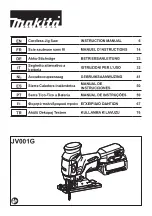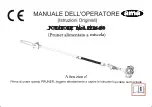
SHOPSMITH 11” BANDSAW
555943
Page 16
Adjusting the Upper Blade Guide’s
Height Lock
The upper blade guide can be locked at any
height 0"-6" above the table. To change the
height of the blade guide:
1.
Swing the upper blade guide’s height
lock handle 90 degrees to the right to
loosen the locking mechanism.
2.
Adjust the upper blade guide so that it’s
no more than 1/4" above the surface of the
stock to be cut.
3.
Lock the guide in place by swinging the
handle so that it points straight back (to-
ward the outfeed side of the table).
4.
If the movement of the upper blade guide’s
height lock seems stiff (or loose), you
need to adjust the tension on the locking
spring (72). This tension is set by a small
headless screw (73) in the left side of the
guide post retainer between the mount-
ing bolts. There should be enough ten-
sion to hold the guide post securely when
locked in place, but not so much that the
lock handle is difficult to operate or that
the guide post will not slide easily when
the lock is released. See Fig A-12.
•
To increase the lock tension, turn the
adjusting screw counterclockwise.
•
To reduce the tension, turn it clock-
wise.
NOTE
The tension on the blade guide’s height lock
is correctly set when you unlock the handle
and the upper blade guide drops smoothly
to 1/4"-1/2" above the tabletop, with no need
to pull it down.
Adjusting the Upper Blade Guide’s
Column Post Screw
The nylon screw (65) is adjusted at the at the
factory and should need only periodic check-
ing. It helps control side-to-side movement of
the column post within the column bracket.
Tighten the nylon screw with a 3/8" wrench to
put more pressure on the column post (thus
eliminating more side to side movement”.
Loosen the nylon screw to put less pressure
on the column post. See Fig. A-13.
ADJUST THE T-SLOT EXTRUSION
1. Use a precision square to double check
your miter gauge for squareness. See Fig.
A-14. Adjust the miter gauge to be square,
if needed.
Figure A-12
Figure A-13
Figure A-14
Figure A-15
Figure A-16
















































